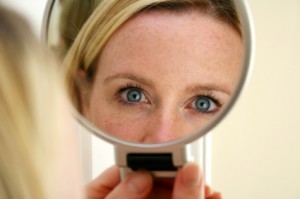What is BDD?
Body Dysmorphic Disorder (BDD) is a mental disorder characterized by a preoccupation with one or more perceived flaws in one’s appearance. Any body part can be the focus of concern. The most common areas of concern involve the skin (e.g., perceived acne, wrinkles), hair (e.g., thinning/balding, excessive body hair), and nose (e.g., size or shape). However, any body area can be the focus of concern, including stomach, buttocks, teeth, weight, breasts, thighs, eyebrows, small body build, legs, lips, arms, hips, cheeks, and ears. Muscle dysmorphia, a form of BDD occurring primarily in males, involves preoccupation with the idea that one’s body is insufficiently lean or muscular. Sufferers often describe themselves as “hideous”, “deformed”, or “ugly” when to others, they appear quite normal or even attractive. BDD affects about 2% of the general population, and it usually begins in adolescence. It affects both men and women, regardless of age, ethnicity, and cultural background.

Individuals with BDD often spend hours a day thinking or worrying about their appearance, causing significant distress and impairment in daily functioning. In addition, individuals engage in time-consuming repetitive behaviors or mental acts (compulsions) aimed at trying to reduce their distress or hide, fix, or check their appearance. Common compulsions include frequently checking one’s appearance in a mirror or phone camera, covering up the perceived flaw with makeup, clothing, or body positioning, comparing one’s appearance to that of others, seeking reassurance about one’s appearance, following a rigid grooming routine, picking at slight imperfections in the skin, or seeking cosmetic treatments, including surgery (often multiple times).
BDD is NOT vanity. It is a serious and often debilitating condition. Individuals who suffer from BDD often experience severe depression, anxiety, and social isolation.
Treatment for BDD
The first-line treatments for BDD are cognitive behavioral therapy (CBT) and medication with serotonin reuptake inhibitors (SRIs). CBT and SRIs can be used on their own or in combination.
Cognitive Behavioral Therapy
Cognitive-Behavioral Therapy (CBT) has been shown to be the most effective therapy for BDD. CBT is a skills-based treatment that helps patients to develop healthier thought, emotion, and behavior patterns. Patients learn to step back from and to challenge negative appearance-related thoughts and beliefs, and to broaden the basis of their self-worth to include non-appearance factors (e.g., personality traits, achievements). Individuals repeatedly approach anxiety-provoking situations (exposure) while refraining from compulsions (response prevention). Exposures are done at a pace that the individual is comfortable with, and a patient is never forced to do anything that they are not willing to do. By confronting anxiety-provoking situations, the patient has a chance to learn that their anxiety and distress will go down, and that feared consequences will not occur, even if they don’t complete rituals. ERP helps patients to significantly reduce time spent performing appearance-related rituals (e.g., mirror gazing, excessive grooming, hiding one’s appearance with certain clothes) and to re-engage with the people, places, and activities they value. Mindfulness and mirror retraining exercises help individuals to see themselves more fully and objectively, without judgment.
Parental involvement is often an important component in treating children and adolescents with BDD. In these cases, the therapist will guide the parent on how to best offer support and avoid counterproductive behaviors, such as offering reassurance (which may reduce anxiety in the short-term but ultimately maintains the anxiety).
Medication
Serotonin Reuptake Inhibitors (SRIs) are currently the medication of choice for treating BDD. Commonly prescribed antidepressants include Escitalopram (Lexapro), citalopram (Celexa), fluoxetine (Prozac), sertraline (Zoloft), and clomipramine (Anafranil).
Current research indicates that a majority of patients experience improvement in their BDD symptoms with these medications. The medications help to reduce obsessive thoughts and compulsive behaviors, as well as decrease anxiety, depression, and suicidal thoughts associated with BDD.
SRIs are used to treat a variety of other disorders, including depression, panic disorder, and social phobia. The prescribed doses of these medications, however, are typically higher for BDD than for other psychiatric conditions. Higher doses of these medications may be particularly beneficial for patients who have not responded to previous SRI trials and who are tolerating the medication well. Each SRI is a little different and therefore, an individual who has not responded to one kind, may see a positive response upon augmenting with an additional medication or switching to a new SRI. Due to the nature of these medications, it may take anywhere from 12-16 weeks to see improvements in BDD symptoms.
For more general information regarding treatment, please read our Treatment Approaches page on our website.
How CORD can help:
Our center specializes in evidence-based treatment for adults and adolescents with BDD. We offer both cognitive behavioral therapy (CBT) and medication in our clinic and in the context of research studies. For more information, please contact:
Adult program:
617-726-6766
Pediatric program:
617-643-2780
Research studies:
If you are interested in learning more about our studies, please contact us at CORDResearch@mgh.harvard.edu.


